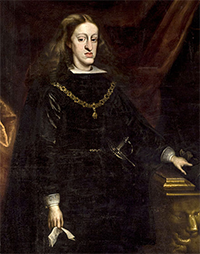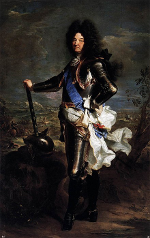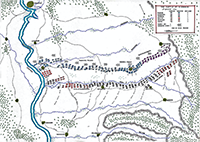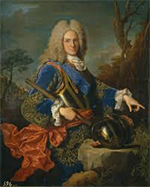The War of the Spanish Succession
The War of the Spanish Succession was nominally what its title suggests but was one of a number of struggles for supremacy on Continental Europe that punctuated the last four centuries of the second millennium. 
The genesis of this conflict was the lack of a clear successor to Spain's King Charles II, who by the 1690s was ailing. Spain by this time was not the dynamic power that had competed for world domination on the high seas and destroyed indigenous empires in the New World; however, the Spanish army and navy were still large, and the empire still included a large number of overseas territories that brought in a good deal of goods and profit. Charles had technically become king in 1665; he was 4 at the time and so his half-brother, John, served as regent and ruler for the next 14 years, until his death in 1679. During this time, Spain had fought against France several times already. Charles was frail and often ill; nonetheless, he had two wives: Maria Louise d'Orleans (who died in 1689) and Maria Anna of Neuburg. Neither marriage produced a child, and so Charles had no direct heir to his throne. Spanish tradition allowed the passage of the crown to a woman or the descendant of a woman, and so Charles's sisters, Maria Theresa and Margaret Theresa, could rightly claim that their children were in line to take the Spanish throne. Maria Theresa's husband was France's King Louis XIV, a descendant of the Bourbon line; Margaret Theresa was married to Leopold I, the Holy Roman Emperor and a member of the Habsburg line. Maria Antonia, the daughter of Margaret Theresa and Leopold, had a son named Joseph Ferdinand. He was 6 in 1698 when he was named in Charles II's will as his heir and successor. 
In that same year, France, Great Britain, and the Dutch Republic tried to impose on Spain a partition of its territory. By the terms of the Treaty of the Hague, young Joseph Ferdinand (right) would still be in control of most of Spanish territory; however, hewing closer to its alternate name, the First Partition Treaty, the agreement would have also handed over the Kingdoms of Naples and Sicily to Louis XIV and France. Rejecting what turned out to a forced diplomatic division of territory, Charles published his will. Just a year later, young Joseph Ferdinand died of smallpox. The Spanish king was still holding on to whatever health he had left, still determined not to hand over his empire to anyone except his handpicked successor. In 1700, in response to yet another proposed partition, he named as his successor Archduke Charles, son of Leopold I. The final change in this arrangement came late in 1700, when Charles was in full decline. He changed his will one last time, naming as his successor Philip of Anjou, the grandson of Louis XIV. This was the will that was in place on Nov. 1, 1700, when Charles II died. Spain duly offered the throne to Philip, who duly accepted. He was named King of Spain on November 16, and Britain and the Netherlands agreed to recognize the new 17-year-old king, Philip V. 
Louis XIV took the opportunity to extend his influence, not only in Spain over his grandson but also elsewhere in Europe. He reneged on the rather friendly working arrangement that he had with England's King William III and recognized James Stuart, the "Old Pretender" and son of William's predecessor, the exiled James II, who was even then ensconced in Louis's court. William died in 1702, but his successor, Queen Anne, took up the cause, allying with the forces of Austria and the Netherlands and, stating the need for Archduke Charles to take the throne of Spain, declared war, in May 1702. Joining what came to be called the Grand Alliance were most of the German states, notably powerful Prussia; the strong state of Bavaria, however, declared for France. Louis XIV had Spain on his side as well. Austrian forces under Prince Eugene of Savoy had made inroads in Italy, and the addition of Dutch and English forces was a significant upgrade to Archduke Charles's chances of taking the throne. However, the combined forces of France and Spain were considerable as well, and French gains in the first two years of the war were numerous. 
The 1704 Battle of Blenheim turned the tide the other way. John Churchill, Duke of Marlborough was commander-in-chief of the allied armies in Flanders. In August 1704, he met up with Prince Eugene near the Danube River, as French forces drove toward Vienna in hopes of capturing it and Archduke Charles. The opposing forces were roughly equal in numbers of men and munitions. On August 2, they gave battle. The battle took place near the small village of Blindheim (from whence comes the English "Blenheim"). The two sides traded fire and positions for most of the day, until French forces faltered and gave way all along the lines. The result was a resounding Allied victory. French losses were very high, numbering in the tens of thousands, and included the commander, Marshal Tallard. In the same year, Dutch and English sea forces seized Gibraltar and gained control of the Mediterranean, a control that they would keep for the remainder of the war. 
The result was proof that French forces were not invincible, as it had seemed to the Allied forces for the first few years of the struggle. After a year in which no significant battles occurred, the Allies scored more successes in 1706, smashing through French defenses in north Italy, leading to a French withdrawal from the region, and driving the French out of the Spanish Netherlands altogether. Of particular significance was another victory led by Marlborough, that at the Battle of Ramillies. Allied success was even greater than at Blenheim, resulting in the deaths of 13,000 French soldiers and the capture of the entirety of the French artillery. Faced with a string of defeats, France's Louis XIV sought to start peace talks. In 1707 and 1708, Allied forces solidified their gains but made no significant new ones. France, however, was still in a position to defend itself, with a large army and a large amount of guns and artillery and money; France was also firmly in control of the alliance with Spain, on whose throne sat a man who wasn't much favored by the Allied forces. Both sides offered concessions, but no firm agreement was reached. The war dragged on, not only in Europe but also in North America, where it was known as Queen Anne's War. French forces fought against British forces in the Atlantic and in what is now eastern Canada. A very large force on both sides took the field at the Battle of Malplaquet, in September 1709. The Allied forces lost one-quarter of their numbers in claiming a strategic victory. Still, they were no closer to achieving their objective of replacing Louis XIV's grandson on the throne of Spain. It wasn't for lack of trying on the part of Archduke Charles, who had led an Austrian force into battle on Spanish soil and had claimed victories in Barcelona and Madrid. Still in control of everything else was the Bourbon heir, who strengthened his hand in 1710 with a couple of large victories at Brihuega and Villaviciosa. 
Peace negotiations came to the fore again, even as the fighting continued, albeit on a smaller scale. With enough details to satisfy all involved hammered out, the Treaty of Utrecht was signed in 1713. This agreement recognized Philip, Louis XIV's grandson, as the rightful heir of Spain, Philip V. However, he had to renounce his right and his descendants' right to succeed to the French throne. In this way, the Allies prevented a joint French-Spanish throne, which had been a primary goal all along. In return, Philip V agreed to cede territory to Allied states, with Sicily and parts of the Duchy of Milan going to Savoy and Charles VI, by then the new Holy Roman Emperor, taking the Spanish Netherlands. England (by this time Great Britain) got to keep Gibraltar and Minorca, giving the British watchful eyes on the Mediterranean. Britain also gained control of Newfoundland and Nova Scotia. The Treaty of Utrecht didn't end the war with the Holy Roman Empire, however. That entity and France fought on for a time, until the twin Treaties of Baden and Rastatt ended the fighting for good in 1714. The three treaties restored a modicum of the balance of power in Europe and brought peace for a time, on the Continent at least. |
|
Social Studies for Kids
copyright 2002–2026
David White




